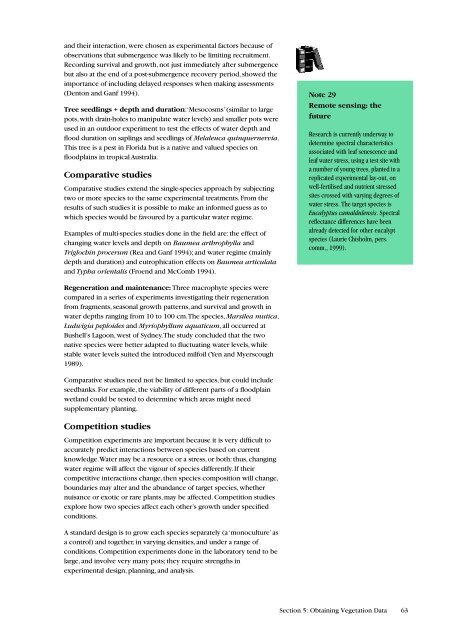Estimating the Water Requirements for Plants of Floodplain Wetlands
Estimating the Water Requirements for Plants of Floodplain Wetlands
Estimating the Water Requirements for Plants of Floodplain Wetlands
Create successful ePaper yourself
Turn your PDF publications into a flip-book with our unique Google optimized e-Paper software.
and <strong>the</strong>ir interaction, were chosen as experimental factors because <strong>of</strong>observations that submergence was likely to be limiting recruitment.Recording survival and growth, not just immediately after submergencebut also at <strong>the</strong> end <strong>of</strong> a post-submergence recovery period, showed <strong>the</strong>importance <strong>of</strong> including delayed responses when making assessments(Denton and Ganf 1994).Tree seedlings + depth and duration: ‘Mesocosms’ (similar to largepots, with drain-holes to manipulate water levels) and smaller pots wereused in an outdoor experiment to test <strong>the</strong> effects <strong>of</strong> water depth andflood duration on saplings and seedlings <strong>of</strong> Melaleuca quinquernervia.This tree is a pest in Florida but is a native and valued species onfloodplains in tropical Australia.Comparative studiesComparative studies extend <strong>the</strong> single-species approach by subjectingtwo or more species to <strong>the</strong> same experimental treatments. From <strong>the</strong>results <strong>of</strong> such studies it is possible to make an in<strong>for</strong>med guess as towhich species would be favoured by a particular water regime.Examples <strong>of</strong> multi-species studies done in <strong>the</strong> field are: <strong>the</strong> effect <strong>of</strong>changing water levels and depth on Baumea arthrophylla andTriglochin procerum (Rea and Ganf 1994); and water regime (mainlydepth and duration) and eutrophication effects on Baumea articulataand Typha orientalis (Froend and McComb 1994).Note 29Remote sensing: <strong>the</strong>futureResearch is currently underway todetermine spectral characteristicsassociated with leaf senescence andleaf water stress, using a test site witha number <strong>of</strong> young trees, planted in areplicated experimental lay-out, onwell-fertilised and nutrient stressedsites crossed with varying degrees <strong>of</strong>water stress. The target species isEucalyptus camaldulensis. Spectralreflectance differences have beenalready detected <strong>for</strong> o<strong>the</strong>r eucalyptspecies (Laurie Chisholm, pers.comm., 1999).Regeneration and maintenance: Three macrophyte species werecompared in a series <strong>of</strong> experiments investigating <strong>the</strong>ir regenerationfrom fragments, seasonal growth patterns, and survival and growth inwater depths ranging from 10 to 100 cm. The species, Marsilea mutica,Ludwigia peploides and Myriophyllum aquaticum, all occurred atBushell’s Lagoon, west <strong>of</strong> Sydney. The study concluded that <strong>the</strong> twonative species were better adapted to fluctuating water levels, whilestable water levels suited <strong>the</strong> introduced milfoil (Yen and Myerscough1989).Comparative studies need not be limited to species, but could includeseedbanks. For example, <strong>the</strong> viability <strong>of</strong> different parts <strong>of</strong> a floodplainwetland could be tested to determine which areas might needsupplementary planting.Competition studiesCompetition experiments are important because it is very difficult toaccurately predict interactions between species based on currentknowledge. <strong>Water</strong> may be a resource or a stress, or both: thus, changingwater regime will affect <strong>the</strong> vigour <strong>of</strong> species differently. If <strong>the</strong>ircompetitive interactions change, <strong>the</strong>n species composition will change,boundaries may alter and <strong>the</strong> abundance <strong>of</strong> target species, whe<strong>the</strong>rnuisance or exotic or rare plants, may be affected. Competition studiesexplore how two species affect each o<strong>the</strong>r’s growth under specifiedconditions.A standard design is to grow each species separately (a ‘monoculture’ asa control) and toge<strong>the</strong>r, in varying densities, and under a range <strong>of</strong>conditions. Competition experiments done in <strong>the</strong> laboratory tend to belarge, and involve very many pots; <strong>the</strong>y require strengths inexperimental design, planning, and analysis.Section 5: Obtaining Vegetation Data 63
















